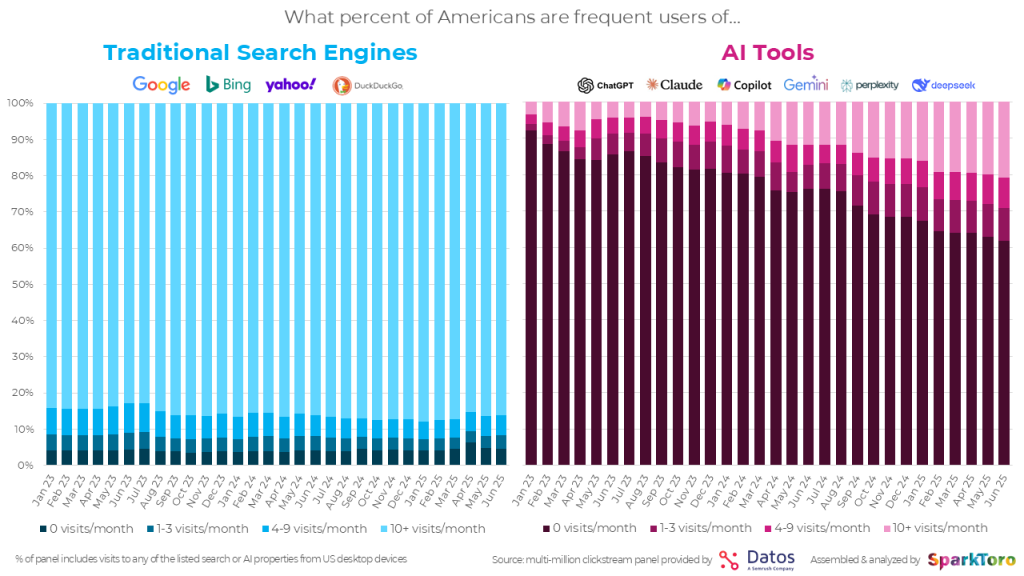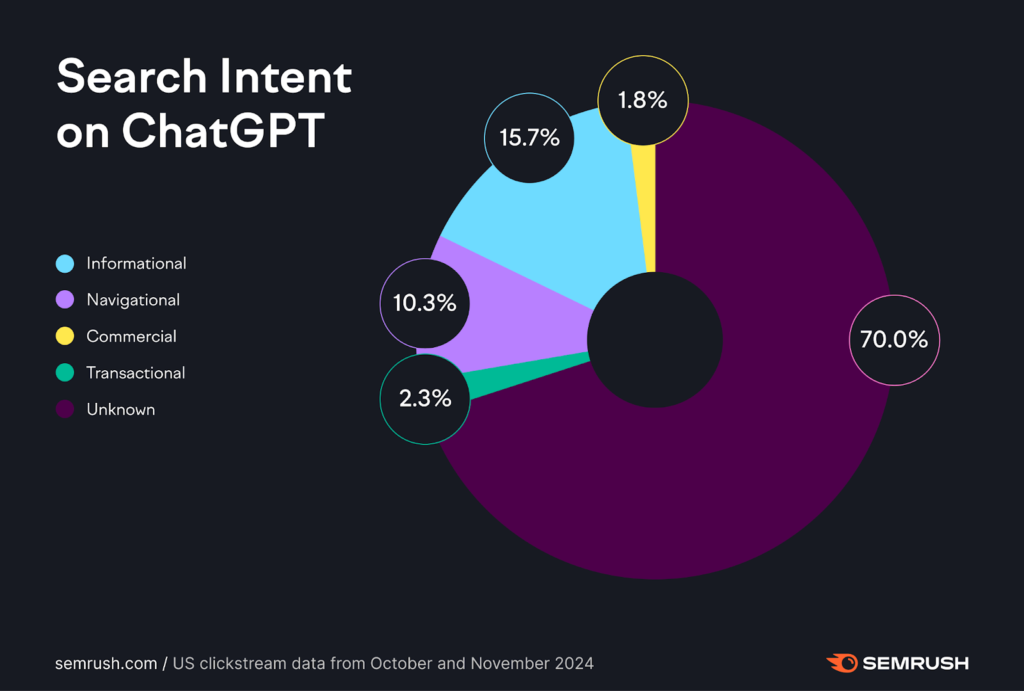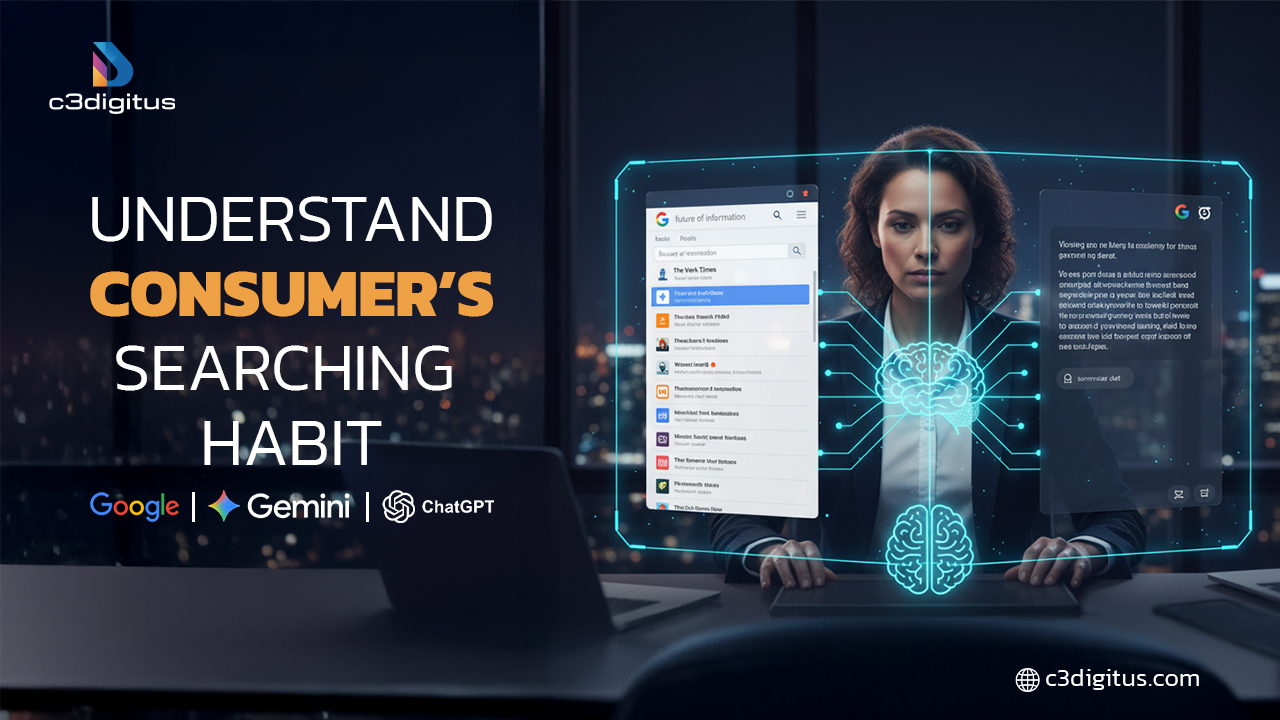The rise of generative AI tools like ChatGPT and Gemini promised a future where traditional search engines might fade into the background. When ChatGPT launched, many tech pundits speculated that Google’s dominance might collapse – some even claimed they personally “never use Google anymore”. As we step into late 2025, however, the data tells a different story. Search isn’t dying; it’s evolving.
Consumers are blending old search habits with new AI tools, and trust plays a bigger role than ever in shaping how and where people seek information. An expert perspective with a decade in AI and marketing reveals a nuanced reality: AI chatbots and Google search now coexist in a hybrid model, each serving different needs in the user’s journey.
The Myth of Search Decline
Early hype suggested that generative AI would replace search engines, but reality shows otherwise. Google’s search traffic has not cratered post-ChatGPT – in fact, it remains robust. A comprehensive Semrush study analyzing billions of web interactions found that ChatGPT adoption isn’t lowering Google usage; it’s expanding the way people search
In other words, people did not stop Googling when they started using ChatGPT. Instead, total search activity actually grew slightly after users’ first ChatGPT session. This supports the “expansion” hypothesis rather than the substitution hypothesis – AI usage is additive to search, not a replacement.
This study illustrates how Google search sessions increased after users began using ChatGPT. Rather than pulling people away from Google, ChatGPT’s introduction expanded overall information-seeking behavior.
There was no statistically significant decline in daily Google searches once people started using ChatGPT – if anything, search volume held steady or ticked upward. This held true across groups: new ChatGPT users, long-term AI users, and even a control group of non-AI users all showed consistent Google usage patterns. Industry research from SparkToro echoes this trend, noting that Google Search actually grew by over 20% in 2024, reaching a staggering 5+ trillion searches in that year.
Google’s CEO himself observed that the introduction of AI summaries in search results correlated with increased search activity and user satisfaction. Far from seeing an exodus, Google’s core search business appears as strong as ever, even alongside the rise of AI tools.
For marketers and businesses, the takeaway is clear: AI has not killed traditional search. Optimizing for Google’s search results is still critical, even as new AI-driven search experiences emerge. The narrative of a search decline was largely a myth – one fueled by anecdotes and media buzz rather than hard data. Users continue to “google it” routinely; they’ve just added AI chatbots into their toolkit for certain tasks.
How Widespread Is AI Tool Adoption?
AI tools are undeniably popular, but they haven’t taken over the world yet. SparkToro’s 2025 research found that around 20% of Americans use AI tools 10+ times per month, and roughly 40% use them at least once a month. At the same time, more than 95% of Americans still use traditional search engines monthly.

That’s the key tension: adoption of AI tools is strong, but the growth curve is slowing. Meanwhile, traditional search engine use remains almost universal. Over 95% of Americans continue to use search engines (Google, Bing, Yahoo, etc.) each month, and a full 86–87% are “heavy” search users (performing 10+ searches per month). This dominance of search has barely budged – The share of Americans who are regular search users has dipped by less than 1% over the past two and a half years.
In short, nearly everyone still searches, even as many people also begin to chat with AI. The data paints a picture of a hybrid behavior: AI tools have a strong niche, but search remains a daily habit for the vast majority of internet users.
The co-existence of these two behaviors is the key tension of 2025. Yes, millions are trying out AI assistants, but at the same time they have not abandoned the familiar Google search box. People appear to choose the tool that fits the task (as we’ll explore next), rather than wholesale switching their entire information-seeking behavior to AI. For businesses, this means your audience is split across channels – and you need to be visible in both the AI realm and traditional search results to capture the whole market.
Habits Are Hard to Break
Why hasn’t AI replaced search yet? The answer lies in behavior. As the Nielsen Norman Group points out, search habits are deeply ingrained. Even when presented with advanced AI tools, many users default back to Google because it’s familiar, fast, and trusted.
This highlights a truth we often overlook: people don’t just want accurate answers, they want answers from places they already trust. Google’s decades of reliability still outweigh the novelty of AI for many. That trust gap is one of the biggest hurdles AI must overcome to shift user behavior at scale.
Right now, AI chatbots, for all their impressive abilities, have not fully provided that decisive incentive for all users. Google’s brand carries decades of credibility and trust that a new tool can’t acquire overnight. People know that a Google search will likely give them a selection of reputable sources (news sites, Wikipedia, official pages) that they can cross-verify. This comfort factor – familiarity, speed, and trust – keeps people coming back to traditional search even as AI alternatives sit ready at their fingertips. As a result, many users use ChatGPT or Bing Chat experimentally or for specific needs, but when in doubt, they “just Google it” because that feels safest and most reliable.
What Tasks Go to AI vs Google?
Rather than an outright replacement, AI tools have become complements to search engines, each used for different types of tasks. Through 2024 and 2025, a clear pattern has emerged in how people decide between asking an AI assistant and performing a traditional search query:
- AI Tools Excel At: tasks involving the generation or synthesis of content. This includes summarizing large chunks of information, brainstorming ideas, drafting written text, getting coding help, language translation, and other creative or open-ended explorations. For instance, a user might use ChatGPT to summarize a lengthy report, to generate ideas for a marketing campaign, or to write a piece of code in Python. These are areas where the AI’s ability to produce coherent text or parse complex input shines.
In fact, analysis of ChatGPT usage shows that about 70% of prompts are for non-search-like functions – things like creating content, answering casual questions, writing code or even composing images – which are not the kind of straightforward fact-finding one typically does on Google. Generative AI can act like an assistant or tutor, helping with tasks that have no single factual answer but rather benefit from synthesis, creativity, or explanation.

- Search Engines Excel At: tasks requiring precise information retrieval, verification, or exploration of sources. Traditional search is preferred for finding authoritative sources and citations, researching products (e.g. reading reviews, comparing specs on different sites), fact-checking claims, navigating to specific websites, and any scenario where having multiple perspectives or the ability to dig deeper is important.
For example, if someone wants to check the credentials of a news story or look up the official documentation for an API, they will likely trust Google to surface the authoritative source. Search engines are also ideal for multi-tab research sessions – you input a query and then open several of the top results to compare information. Users tend to turn to Google when they want to see multiple viewpoints or need high confidence in accuracy, because the search results page provides a variety of sources that the user can evaluate.
User behavior research reinforces this division. Nielsen Norman Group’s studies found that while people appreciate AI’s ability to streamline tedious research tasks (like scanning long texts or compiling information from many sources), these AI tools still don’t eliminate the need for traditional search in many cases.
Participants in their study often used AI to get a quick overview or draft, but then went to Google to verify facts or find an official source to ensure the information was credible. AI might help a user formulate the right question or summarize conflicting answers, but when it comes time to “double-check” or get the final answer from a trusted source, search engines come back into play.
A Datos analysis in early 2025 quantified this split clearly: only 30% of ChatGPT’s prompts were comparable to traditional search queries seeking information or navigation, whereas the majority 70% were for other purposes like creative assistance or coding help. In essence, people use AI for exploration and creation, but use Google for validation and decision-making.
A consumer might ask an AI tool to “give me a summary of this product’s pros and cons” but then use Google to read customer reviews and ensure those pros/cons are reflected in reality. Or a student might have ChatGPT explain a concept from a textbook, then use Google to find the original reference or more in-depth materials on that concept.
Understanding this division of labor between AI and search is crucial for anyone in content creation or marketing. It means that providing value to your audience may require offering both concise, AI-friendly answers (for when an assistant tries to summarize your content) and in-depth, authoritative content (for when users or search algorithms look for trusted sources). Users are effectively blending tools to accomplish their goals: perhaps starting with a quick AI-generated answer, but then pivoting to search for corroboration. Each step in that journey plays a role.
Trust Is the New Battleground
The competition between AI tools and traditional search isn’t just about which is faster or more convenient – it’s increasingly a battle over trust and credibility. In 2025, users are more aware than ever that “not everything you read on the internet (or from an AI) is true.” Generative AI’s well-documented issues with factual accuracy and “hallucinations” have created a trust gap that limits how and when people rely on these tools.
AI chatbots have had some high-profile missteps. They can produce confident answers that are completely wrong, and even fabricate sources or citations to back up their claims. For example, ChatGPT has been noted to hallucinate fake URLs and references – one report found it even invented article links to news sites (including links to outlets that were OpenAI’s own partners!) when no such articles existed. A Columbia University study in 2025 put several AI search engines to the test and the results were eye-opening: across 1,600 queries, the AI systems failed to retrieve the correct citation more than 60% of the time.
Some models were especially bad – Google’s Gemini and X’s Grok-3 bots actually provided more fabricated links than correct ones in the tests, pointing users to dead pages or non-existent sources routinely. Equally troubling, the researchers noted that these tools often answer with overconfidence, seldom warning the user when they might be unsure.
In short, today’s AI can sound convincing while being wrong, which is a recipe for eroding user trust.
From the perspective of an experienced marketer, i can say that Trust is the new battleground. Whether content is delivered via an AI assistant or a search result, users will favor the channel that consistently gives them confidence. Right now, Google holds a substantial trust advantage by virtue of longevity and a clear linking-out system. AI tools need to close the trust gap by improving factual accuracy, transparency, and by integrating with trusted sources. This is one reason we’re seeing AI being embedded into established search engines (e.g., Bing’s chat mode, Google’s SGE) rather than existing purely as separate chat apps – marrying AI’s convenience with Google’s credibility is a natural path to win user trust.
What This Means for Marketers and Businesses
So, how should businesses adapt to this blended search landscape?
1. Optimize for Both Worlds: Traditional SEO is still critical, but content must also be structured for AI discovery. Think schema markup, concise definitions, and content that AI can easily pull into overviews.
2. Prioritize Credibility Signals: Building EEAT (Experience, Expertise, Authority, Trustworthiness) isn’t just an SEO best practice, it’s what convinces both humans and AI systems that your content is worth surfacing.
3. Design for Hybrid Journeys: Recognize that consumers may start with AI, then move to Google, then circle back. Mapping content across that journey will keep you visible at every step.
FAQs on Search Habits and AI Tool Trust in 2025
1. Are AI tools replacing Google search in 2025?
No. Data from Semrush shows Google’s usage has not dropped after ChatGPT adoption. Instead, people use both AI tools and search engines depending on their needs.
2. How many people use AI tools regularly?
According to SparkToro, about 20% of Americans use AI tools 10+ times per month, while around 40% use them at least once a month. In contrast, more than 95% still use search engines monthly.
3. What kinds of tasks do people prefer AI tools for?
Research from NNGroup shows that people rely on AI for summarizing, brainstorming, drafting, and coding help. For fact-checking, product research, and authoritative sources, traditional search engines remain the first choice.
4. Why do people still trust Google more than AI tools?
Google has decades of credibility and consistent performance. AI tools sometimes generate errors or fabricated citations, which creates hesitation. Building transparency and reliability is essential for AI to earn equal trust.
5. What should businesses do to adapt to this shift?
Businesses should optimize for both worlds. Continue with traditional SEO, but also create content that AI systems can surface in overviews. Focus on credibility signals like EEAT (Experience, Expertise, Authority, Trustworthiness) to strengthen both human and AI trust.
The Bottom Line
Consumer behavior in 2025 shows that we’re not witnessing the death of search – we’re witnessing the expansion of search into new forms. People are happily blending AI tools with traditional search engines, using each for what it does best. Habits and trust play decisive roles: users stick with what’s familiar and trustworthy for critical queries, even as they experiment with AI for more creative tasks. For businesses and marketers, the winners in this new landscape will be those who stop framing it as “AI vs. Google” and instead ask: “How can we meet users wherever and however they’re searching?”
That means maintaining a strong presence in search engines and embracing the opportunities presented by AI-driven tools. By earning user trust and optimizing content for a hybrid search reality, brands can ensure they stay visible and relevant no matter how search evolves. In this new era of search, the spoils go to those who are credible, adaptable, and truly user-centric – the ones ready to serve answers whether it’s via ten blue links or a friendly AI chatbot.





